Mark Caney's Blog, page 11
November 10, 2015
More stories of dolphins helping humans
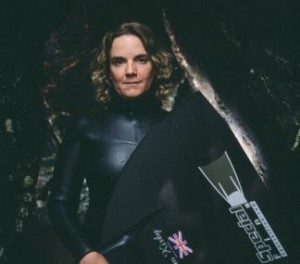 Sam Amps
Sam AmpsA good friend of mine is Sam Amps who is one of the top freedivers and was very instrumental in helping us write the PADI Freediver program. She just told me of two interesting stories she has just heard about dolphins helping people. She says, “A guy who came on a Freedive course told me that he had not really Freedived before but decided to have a go. He was on his own and started doing quite well. He was fine and got himself down to about 15m. At the bottom he realised he’d over done it and started worrying he wouldn’t get back up. A dolphin appeared and swam up alongside him, then waited next to him on the surface until he was clearly OK!
Also, Roger Mallinson, the submariner guy I met who got trapped in the deep Atlantic for several days and nights in his sub said they could hear dolphins around them the whole time they were submerged. When they were rescued they could hear them the whole way up. They surfaced, the dolphins watched the rescue and swam off!”
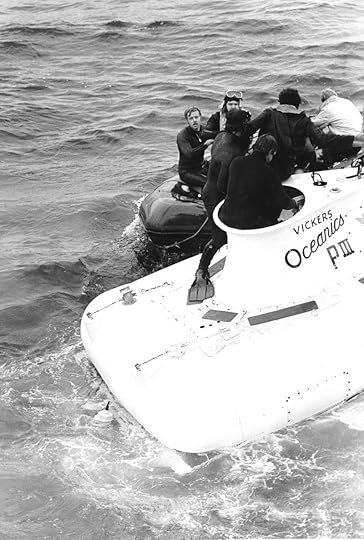 Rescue of Roger Mallinson and Roger Chapman
Rescue of Roger Mallinson and Roger ChapmanBy Mark Caney

November 9, 2015
Article – Did a dolphin sense my feelings of grief?
Susan Casey hadn’t given that much thought to dolphins when she went for a swim off the north shore of the Hawaiian island of Maui one afternoon in July 2010. In fact, she was more worried about sharks. The weather was bad – low clouds and a stormy sea – and there had been a recent spate of shark attacks in the area. It was dusk and no one else was in the water.
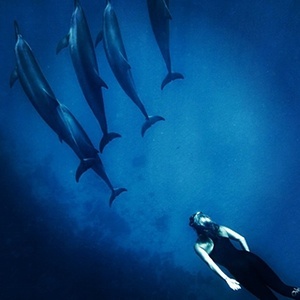 Susan Casey swimming with dolphins. Photograph: Instagram
Susan Casey swimming with dolphins. Photograph: InstagramBut Casey was drawn to the shoreline. She was flying back to her life as a magazine editor in New York city the following day and this was the last chance she would have to kick out against the waves.
There was another reason she chose to swim in such perilous conditions. Two years previously, her father, Ron, had died suddenly of a heart attack at the age of 70. Casey had struggled with the shock of his death. For months, she had been feeling untethered and lost. Situations that might previously have scared her now elicited only numbness. So she put on her goggles and headed out to the water, unaware that what she was about to experience would change her life for ever.
As Casey was swimming, looking down at the seabed, she saw a shadowy body pass diagonally beneath her. Then she caught sight of a dorsal fin. From below, several more shadows appeared and soon she found herself circled by a pod of 40 to 50 spinner dolphins. It was unusual for them to approach in this way; spinner dolphins are renowned for their aerial acrobatics and they normally jump around on the water’s surface and leap through the air.
“They were sort of surrounding me,” Casey says now, drinking a green tea in a beach restaurant in Maui, a few miles down the coast from where she was swimming that day five years ago. “I just remember it was sort of amazing because they can be so fast and I wasn’t even swimming at that point so they were obviously trying to stay around me.”
There was, she recalls, “a definite sense of presence”. One of the bigger spinners approached. Casey and the dolphin looked at each other, exchanging what she describes as “a profound cross-species greeting”. She thought about the grief she was feeling at her father’s death and she wondered if it were possible the dolphins had somehow sensed this. “Did they know?” she says. “Could they tell?”
From this single interaction, Casey was inspired to spend five years writing and researching Voices in the Ocean, a fascinating book of non-fiction reportage about the haunting and extraordinary world of dolphins, published in August in the UK.
It’s not unusual for people to have such a strong reaction to swimming with dolphins. The animals have long held a visceral allure for humans. They are among the most intelligent mammals on the planet and use sophisticated internal sonar to navigate and to detect objects several miles away in a process known as echolocation. Research has shown that dolphins communicate with each other through clicks, trills and whistles. They are even thought to speak in dialect. Plus, as Casey points out in her book: “Maybe we are hard-wired to love any animal that looks like it’s always smiling.”
Whatever the reason, that encounter with the spinner dolphins changed her.
When she got back to shore, Casey says: “I felt high … I dried off, started driving away and I started thinking how incredible, beautiful they were. I was really present and really happy in this very deep way. I drove for about 20 minutes and all of a sudden, it occurred to me I’d forgotten to feel sad. It didn’t last, but something lifted in that moment that was interesting.” She pauses. “It was really interesting.”
To put this into context, it is important you know that Casey is not a New Age, touchy-feely type. She is not much given to sentimental hyperbole or gushing spiritual insights. At the time, she had one of the plummest jobs in journalism: editor of O, The Oprah Magazine which regularly shifted one million copies a month.
Before that, Casey had been the editor-in-chief of Sports Illustrated Women and had a spell as creative director at Outside magazine, a highly regarded publication for literary writing about the outdoors. (During her time there, Casey commissioned the writer and mountaineer John Krakauer to write about the base camp at Mount Everest in 1996. His 17,000-word piece about a disastrous expedition during which several climbers died became a book, Into Thin Air, which has just been adapted into the blockbuster film Everest.) She is the author of two previous works of non-fiction, the New York Times bestseller, Devil’s Teeth(about sharks), and The Wave (about giant waves).
“I was happy in New York,” says Casey, “but I really did feel I had this urgent – I’m not sure I’d call it a mission – a need to connect with nature.”
Read full story: The Guardian

November 8, 2015
NOAA to investigate dolphin deaths during Navy sonar exercise
 Federal authorities said on Thursday they were investigating the deaths of two California common bottlenose dolphins that stranded and died on beaches just a few miles apart in San Diego a day after the U.S. Navy conducted a brief exercise with sonar.
Federal authorities said on Thursday they were investigating the deaths of two California common bottlenose dolphins that stranded and died on beaches just a few miles apart in San Diego a day after the U.S. Navy conducted a brief exercise with sonar.
Jim Milbury, the West Coast spokesman for the National Oceanographic and Atmospheric Administration (NOAA), said that necropsies were being performed and that an investigation was underway.
The dolphins, apparently part of a population of 323 remaining California common bottlenose dolphins, were found on Oct. 21 at Imperial Beach and the Silver Strand, less than 10 miles apart.
Navy officials confirmed that ships were using mid-frequency sonar in the area “for a little over an hour” as part of a training exercise on Oct. 19 and Oct. 20. The ships are part of the Silver Strand Training Complex, according to Lieutenant Julie Holland.
The Navy won federal permission to train with mid-frequency sonar, which sends out a loud ping underwater, in December 2013 despite environmentalists’ concerns over the harmful effects of such sonar on underwater mammals that rely on their hearing, including whales and dolphins.
“A single ping can permanently deafen a marine mammal 100 meters (yards) away,” said David Henkin, an environmental attorney.
The investigation comes as part of a September settlement with the environmental group, Earth Justice. The group sued the agency for giving the Navy a permit to conduct training exercises using mid frequency sonar and explosives in areas where ocean mammals could be injured or killed.
Full story: Yahoo News

November 4, 2015
Animal (Dolphin) Communications, Information Theory, and the Search for Extraterrestrial Intelligence (SETI)
Extract from article by Laurance R. Doyle, Senior Research Scientist at the SETI Institute Carl Sagan Center
The idea that we can learn about possible extraterrestrial (ETI) communication systems by studying non-human communications on Earth is similar to the astrobiological idea that one might learn more about exobiology by studying the extremes of life on Earth. Such study was taken up by Dr. Brenda McCowan of University of California, at Davis, Dr. Laurance R. Doyle of the SETI Institute, and their PhD student at the time, the now Dr. Sean F. Hanser. Early work was also helped on by Dr. Jon M. Jenkins also of the SETI Institute at the time.
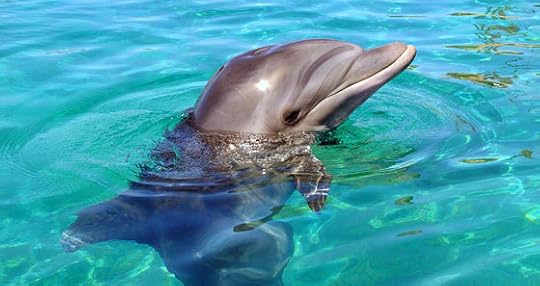
To begin this study, we selected terrestrial species that are socially complex, but largely depend on acoustic signaling to communicate – that is, bottlenose dolphins and humpback whales. We also included squirrel monkeys. The tools we chose to apply were signal classification methods (largely the K-means cluster 60-point contour) and the broad mathematics of Information Theory discovered by Dr. Claude Shannon of Bell Laboratory in the late 1940s. Originally developed to ascertain the amount of information going through telephone lines, we applied it to quantify the amount of information, in bits, that was being communicated between captive, adult bottlenose dolphins.
A linguistic relationship known as “Zipf’s Law” appears to be a necessary but not sufficient condition for complex communications. In this relationship, the (base ten logarithm) of the frequency of occurrence of the various signal types (assumed to be sufficiently sampled so it can represent a probability) is plotted in logarithmic rank order, and a complex communication system will always give a -1 slope for the distribution of the signals types (letters, words, or phonemes). Although Zipf’s Law applies to many systems, a communication system that is not coded must have this distribution to have the potential for complex relationships between the signals. In human languages we would call this “syntax” in the sense of rules of spelling and grammar.
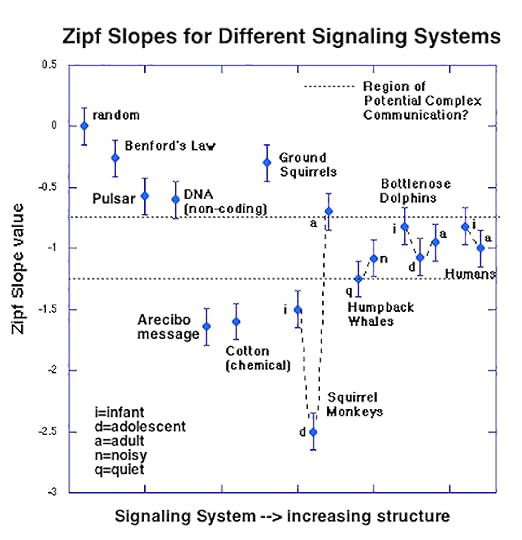 Zipf slopes for various signaling systems. This figure shows the slope of the linear regression of the log10 of the frequency of occurrence distribution of a signaling system against the log10 of the rank order (1st, 2nd, 3rd, etc. most frequent). We indicate a region around the values of the regression slope = -1 (dotted horizontal lines) where the Zipf relation may be indicative of a signaling system with potential significant communicative complexity. We point out that this diagram is indicative of what may be achieved but that, to some extent, we may be comparing ‘‘apples with oranges’’ in this diagram, since the sense, use, and meaning of the signals therein classified are unknown for most non-human species. (Figure after L.R Doyle et al. / Acta Astronautica 68 (2011) 406–417.)
Zipf slopes for various signaling systems. This figure shows the slope of the linear regression of the log10 of the frequency of occurrence distribution of a signaling system against the log10 of the rank order (1st, 2nd, 3rd, etc. most frequent). We indicate a region around the values of the regression slope = -1 (dotted horizontal lines) where the Zipf relation may be indicative of a signaling system with potential significant communicative complexity. We point out that this diagram is indicative of what may be achieved but that, to some extent, we may be comparing ‘‘apples with oranges’’ in this diagram, since the sense, use, and meaning of the signals therein classified are unknown for most non-human species. (Figure after L.R Doyle et al. / Acta Astronautica 68 (2011) 406–417.)We discovered that adult bottlenose dolphins obey this Zipf’s Law relationship so that there could exist “syntax” within their communication system. Why would such syntax exist? For one thing, this syntax enables the recovery of errors in the transmission, which definitely has survival value. A human example might be the recovery of missing letters in a poorly copied manuscript by the use of spelling rules.
We also found that bottlenose dolphin communication follows a Zipf’s Law distribution of signals. On the other hand, human babies do not follow a Zipf’s Law distribution to their signals and, interestingly, baby bottlenose dolphins also do not follow a Zipf’s Law distribution, rather they follow the same distribution that human babies follow. In other words, baby bottlenose dolphins “babble” their whistle language. By the time they are 2 years old, they have acquired the -1 slope adult language and start to whistle like adults.
We have also applied Zipf’s Law to stellar sources such as pulsars, and their signals do not obey Zipf’s Law. We have then gone on to apply Shannon Information Entropy to humpback whales, and we discovered that they have enough “syntax” to recover mutual communications that have lost up to 40% of their signal content (in this case due to boat noise). This defines their language as intelligent communication, one that has many “rules” interconnecting the signals of various types, thereby maximizing error recovery.
Read full article: SETI institute

November 3, 2015
Dolphin Bay Phuket dolphinarium opens despite criticisms from animal activists
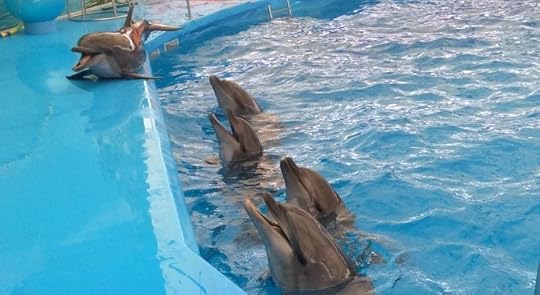
More than 200 people arrived Saturday at the Dolphin Bay Phuket to witness the first show of the new marine park, despite the controversy surrounding the venue.
The show started at 10:30am, with many parents bringing their children to view the spectacle of dolphins guided by trainers, performing tricks and aerial stunts with balls and hoops.
Many of the visitors at the morning show, which was reserved exclusively for Thais, gave glowing reviews of the performance to reporters at the scene.
Supreecha Suthamanondh, general manager of Phuket Aqua Project Co. Ltd., said Dolphin Bay will open to the public tomorrow with promotional entry prices for the entire month of November.
Five dolphins and two seals flown in from the Ukraine arrived at the THB100mn Nemo marine park two weeks ago, amid much controversy.
However, online campaigns against the facility produced copies of documents showing the company allegedly obtained at least some of the dolphins from Japan, renowned for the infamous annual dolphin slaughter and capture for entrainment businesses at Taiji Cove.
Full story: Coconuts

October 22, 2015
October 19, 2015
October 16, 2015
How thousands of dolphins die for your cheap tuna sarnie
They are perhaps the most intelligent species on earth after humans. And they are dying torturous deaths to fill our lunchtime sandwiches.
A terrifying new report has found that 98 per cent of canned fish sold by Britain’s best-known purveyors, John West, are caught by methods which indiscriminately kill other marine life — including dolphins.
This is despite a claim from the company that its entire output would be sustainably caught by 2016. Not only that, it emerged this week that John West’s claims that the contents of its cans are ‘100 per cent traceable’ is false. The company has a label on its cans saying that customers can use its website to track where the tuna in each can came from.
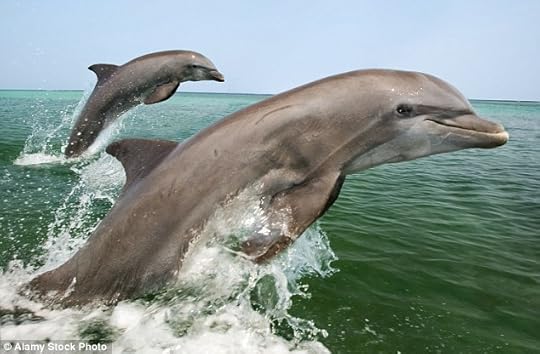
But the website does not allow shoppers to trace tuna from Thailand — which has been warned with a ‘yellow card’ by the European Commission over illegal fishing activity — even though cans of John West tuna from Thailand are on sale here.
Ariana Densham, oceans campaigner at Greenpeace UK, is scathing. ‘It’s clear John West has no intention of keeping its sustainability promise,’ she says.
‘A pathetic two per cent of its tuna is caught in a way which minimises harm to other marine life.’
Source: Mail Online

October 15, 2015
Amazing photos as orca catches hapless porpoise for dinner
The Orca leaping out of the water catching the little porpoise
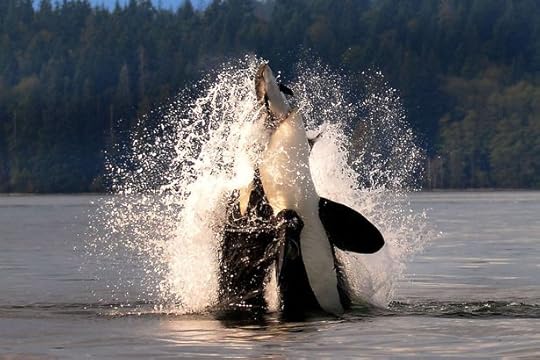
The majestic mammal leaps out of the water in triumph after managing to catch an elusive baby porpoise.
The mighty whale and his pals were in hot pursuit of the helpless little porpoise – and this one struck lucky as he went in for the kill, making a splash as he dramatically smashed the surface of the water with his tasty prize.
The rare sighting at Discovery Bay in British Columbia, Canada, was caught on camera by photographer Nina Richardson Bowling.
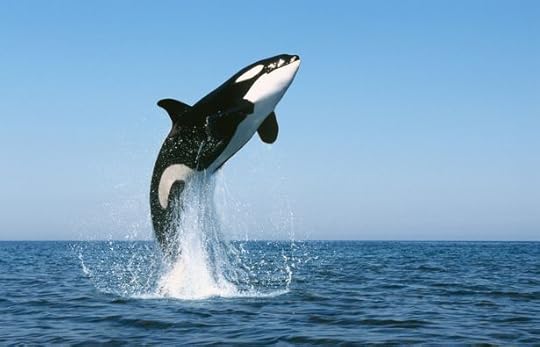
The 59-year-old was returning from a grizzly bear tour when her and her party spotted a pod of whales in hot pursuit of the much-smaller mammal.
And she described how, briefly at least, it looked like the little fella may just escape before the orca dramatically rose up from the water proudly showing off its prey.
Nina, from Colorado, said: “All of us watching were spellbound by the scene unfolding in front of us.”
Orcas are highly intelligent, highly adaptable and able to communicate and coordinate hunting tactics.
Classed as an apex predator – the top of the food chain – they will hunt fish, squid, seals, sea lions and seabirds and even whales much larger than themselves.
Full story: Mirror

October 14, 2015
12-Year-Old Films Pod Of Killer Whales Attacking A Dolphin
There’s a reason orcas are commonly called killer whales, and last month, three fishermen witnessed it firsthand.
In late September, Richard Baker and his 12-year-old son, Jackson, were fishing in New Zealand’s Hauraki Gulf when they saw a pod of orcas swimming near their boat, according to New Zealand website Stuff.
Jackson grabbed a camera and began filming the magical moment, but what he caught on camera instead was a deadly chase.
The orcas, as seen in the clips below, were hunting a dolphin for their next meal.
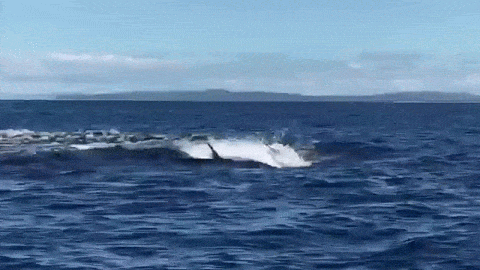
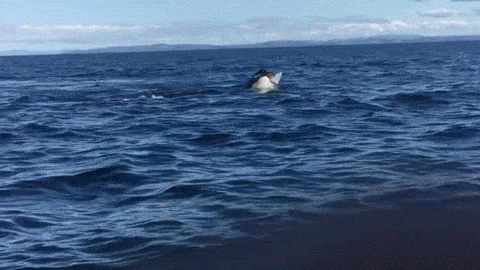
Orcas, which are actually not whales but members of the dolphin family, are one of the ocean’s top predators, thanks to their sheer power and killer hunting techniques.
It’s not uncommon for them to feed on other species of dolphin, as well as several species of whale, sea lions and even the ocean’s supposed apex predator — great white sharks.
“They can take pretty much whatever they want,” John Ford, a research scientist and adjunct professor with the University of British Columbia’s Marine Mammal Research Unit, said in a 2011 interview with Nature.com.
Orcas pursue their prey in pods of up to 40 individuals, although they have been known to frequent the Hauraki Gulf, where Jackson’s video was filmed, in pods of five to 15.
They also use a cooperative hunting technique, according to National Geographic.
“Each whale has a role,” Tiu Similä, a biologist and expert on orca hunting, told National Geographic of the orca hunting strategy.
“It’s like a ballet, so they have to move in a very coordinated way and communicate and make decisions about what to do next,” Similä said.
Full story: Huffington Post






